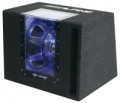—
Closed box. The simplest type of case: a box closed on all sides with a speaker (speakers) on the front panel. The advantages of such models are high accuracy of sound transmission and low cost, the disadvantages are low sensitivity and somewhat “flat” bass.
—
Phase inverter. A classic phase inverter is a hollow tube connecting the internal volume of the case with the outside world (however, there are other options for such a connection). The length of the phase inverter channel is chosen so that the sound waves of a certain range, passing through it, are inverted in phase relative to the waves from the speaker (hence the name). This improves (in particular, "deepens") the sound of the subwoofer and allows you to achieve good performance with a small cabinet size. On the other hand, the sound stream in the tube creates a certain additional noise.
—
Strip. A design that combines the features of a closed box and a bass-reflex enclosure. One of its parts is made closed, and the second is equipped with a phase inverter tube; between them is a partition, on which the main speaker is located. Unlike previous types, the speaker is entirely inside the case. Strip-line enclosures provide louder sound than boxes or bass reflexes, with sound quality comparable to the latter. The disadvantage is the complexity of the design, as a result — a slightly higher price.
Sensitivity determines the loudness of the subwoofer when a signal of a certain power is connected to it: with equal signal power and impedance (see below), the subwoofer with the higher sensitivity will sound louder.
The presence
of protective devices in front of the main speaker of the subwoofer — this can be the grill itself, metal rods, plastic elements, etc. Such devices protect the device from foreign objects to a certain extent, and they can also play an aesthetic role.

